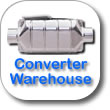Catalytic Converter FAQ
Q What is A Catalytic Converter?
A It is a device which chemically converts harmful exhaust
gases, produced by the internal combustion engine, into harmless
carbon dioxide and water vapor. The converter was developed
to meet stringent emission reduction levels as set forth
by the Federal ERA and California Air Resources Board. Since
the 1975 model year, vehicle manufacturers have used catalytic
converters and other emission control devices, to meet those
emission reduction levels.
Q What is A Substrate?
A It is the material inside the shell of the converter. There
are two types of original equipment substrates: Pelletized,
which consists of thousands of BB-sized ceramic pellets and
Monolithic, which is a ceramic "honeycomb" style.
The replacement converters listed in this catalog have monolithic
substrates.
Q What is A Catalyst?
A It is a thin coating of precious metals (rhodium, platinum
and paladium) applied to the surface of the substrate material.
Its function is to assist in the chemical reactions that
are required to lower the emission levels.
Q What Are Oxidation And Three-Way Converters?
A Oxidation converters control two pollutants-carbon monoxide
and hydrocarbons. These gases come into the converter accompanied
by enough oxygen to result in oxidation (burning) by flameless
combustion. They pass through the substrate which causes
the oxidation process to speed up changing them into harmless
water vapor and carbon dioxide.
Three-Way converters (also known as Oxidation/Reduction converters)
perform the same function as oxidation converters plus they
are designed to reduce levels of oxides of nitrogen. Some three-way
converters are equipped with an Air Injection Tube. The additional
air, which comes from an air pump, assists the chemical reaction
in the oxidation catalyst.
Q What is the ERA Policy On replacement Converters?
A In August, 1986, the U.S. Environmental Protection Agency
issued new guidelines for the construction, efficiency and
installation of aftermarket converters. The converters listed
in this catalog have been designed, tested, manufactured
and proven to meet the ERA policy and emission reduction
requirements.
Q What Does the December 18,1986 Cut Off Date Refer to?
A Replacement converters built before December 18, 1986 do
not comply with the latest EPA policy. The sale and/or installation
of those converters may be prosecuted as a tampering violation
of the Clean Air Act. Converters built after that date are
in compliance. Those converters are permanently labeled with
a date code by the manufacturer. The four digit code refers
to the month and year of manufacture (example: "0488" is "April,
1988").
Q How Do You Determine Which Converter To Use?
A A vehicle with the wrong type of converter may be considered
a tampering violation by the EPA. It is important to use
the converters listed in this catalog for the specific applications
shown. Sometimes it is difficult to determine what type of
converter is on a certain vehicle.
Q Why Doesn't A Vehicle Pass An Emissions Test?
A When a Converter does not function, no exhaust gas conversion
takes place. Usually the vehicle will run fine, but it will
not pass emission test standards. This may be caused solely
by a worn or damaged converter. But, it is difficult to diagnose
because it involves other emission system components, as
well. The most common cause of this problem is lead contamination
within the converter. Use of leaded fuel is usually the source
of the contamination.
Q What Makes A Converter Become Red Hot?
A A Converter will get red hot when raw fuel is introduced
directly into it. This is not the problem of the converter
itself, but the result of a problem with the fuel system
or ignition that allows unburned fuel to pass through the
engine to the converter. Possible causes are improper ignition
timing, fouled spark plugs, and air pump failure.
Q What Causes A Converter To Become Clogged?
A If a converter is operated too long at a high temperature,
its substrate may "melt down" and turn into a solid
mass inside the converter. The vehicle may seem sluggish,
as if there were a loss of power. Again, an engine and/or
fuel system malfunction is allowing a rich fuel mixture to
reach the converter. If the problem is not diagnosed and
corrected, future converter failures may occur.
Q What Causes The Replacement Rubber Air Hose To Burn or Melt?
A The air pump or check Valve could be malfunctioning. The
universal hoses listed in this catalog are made of a high
temperature (up to 550° F) Silicone rubber. Their purpose
is to transport air (up to 125° F) to the converter.
Under proper operating conditions they will not burn or melt.
However, if hot exhaust gases back-up from the converter
into the hose, damage could occur.
Q Why Does The Exhaust Have A "Rotten Egg" Smell?
A Many times on first start-up in the morning, the exhaust
may smell like "rotten eggs". This is due to rich
fuel condition with a cold engine. However, as the engine
warms up, this smell should go away. If it does not, converter
damage could possibly follow with extended driving.
Q What Is The Converter Warranty?
A The converters listed in this catalog are warranteed to meet
the Federal ERA emission reduction requirement for 25,000
miles. Also, the converter shell is warranteed for five years
or 50,000 miles, whichever occurs first.
Q What Should Be Done With The Warranty Card?
A The registration section must be filled in by the installer
and mailed to the address indicated. The warranty statement
and sales receipt should be kept by the consumer for future
reference.
|






